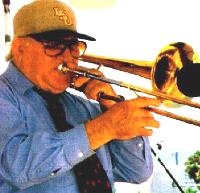
CARL FONTANA
For a night, Bootlegger is the Fontana room
Jerry Fink in Las Vegas Sun
LAS VEGAS SUN, September 27, 2002
Reproduced here by kind permission of Jerry Fink
A roomful of fans at Bootlegger Bistro on Monday night anxiously
awaited the arrival of Carl Fontana.
Most wondered if the legendary 74-year-old jazz trombonist would show up at a tribute organized for him by keyboardist Gus Mancuso, another Las Vegas jazz legend and a close friend of Fontana's for more than 40 years.
"I was a trombone player, but he hired me on the piano at the Moulin Rouge in 1955," Mancuso recalled. "Once I heard Carl on the trombone, I decided maybe I should be a piano player."
Fontana is in an advanced stage of Alzheimer's, which robs victims of themselves -- eating away the mind, the personality, and leaving a shell. Family and friends first noticed Fontana's illness a couple of years ago. He was becoming forgetful, but he could remember his music and he continued to play publicly with his flawless renditions of such classics as "Emily.
As recently as January he performed at the Jazzed Cafe with Marv Koral and his All-Stars and with Irv Kluger at Pogo's, even though his condition was becoming worse. Mancuso didn't know if his friend would perform at the Bootlegger. Just in case, he placed a trombone next to a stool in front of the piano and held his breath.
"Would he play?"
Carl Fontana is an international name in the jazz world, once called "the trombonist's trombonist."
Ken Hanlon, a professor of music at the University of Nevada, Las Vegas is writing a biography of Fontana, who moved to Vegas in the early '50s.
"If there's a tune Carl doesn't know, I don't know what it is," Hanlon said during an interview earlier this year. "Carl was never talkative. He's a guy who let his horn do his talking."
Fans wondered that if Fontana did show up at the tribute in his honor, would his trombone speak?
It was a voice fellow musicians who packed the room had heard many times. Fontana inspired some of them to become trombone players, such as Brian O'Shea. He performed with many of them, including bassist Chris Gordan.
Vocalist Joni Janak flew in from Denver to attend the event and to sing to her mentor. She first worked with Fontana in 1991. Together they performed at such venues as Alexis Park and the Pierce Street Annex.
"He's such a kind man, and so easy to work with," Janak said. Perhaps his genteel demeanor is a result of his Southern upbringing. He was born in Monroe, La. After graduating from Louisiana State University, Fontana performed with some of the top musicians in the world, too many to name. And he developed his trademark "doodle tonguing."
Trombonist Bob McChesney wrote a book on the technique, said to be a "self-defense against tenor saxophone players" -- it allows the trombonist to play rapidly and cleanly and to keep up with the saxophonist.
Over the next 50 years, Fontana earned the respect of millions of jazz fans around the world. Many of them mailed tributes in response to Monday's affair.
A couple of hundred were at the Bootlegger. They broke into applause when the frail giant finally entered the room, assisted by his daughter, Felicia Valenty, who helped him to a seat of honor near Mancuso's band.
It was difficult to tell if Fontana was aware of what was going on around him, although he would nod when spoken to. Friends swore that behind the curtain that has been drawn across his mind, he knew.
Emotions were fragile. Tears flowed freely as musicians played and Janak, Lorraine Hunt, Maggie Mancuso (Gus' wife) and others performed.
Someone placed a trombone in Fontana's hand during
the singing. The once towering musician held the familiar instrument
in his left hand, placed the mouthpiece to his lips and began to blow
gently as he worked the slide.
His motions and his timing were perfect -- but no sound came from the
horn.
The voice was silent.
Afterward, his daughter spoke on behalf of her father. "People don't realize that when I took him there, in the car he was so alert and very talkative," she said. "He said so many things. People don't understand there are moments of clarity. Memories pop up like a bingo ball. He heard and he saw everything that was going on, but it's hard for him to take in the thoughts and process them."
Valenty felt she had to answer the few people who might have criticized her for taking her father into public.
"A lot of people are heartbroken about seeing him that way," she said. "But he is still very much alive. He has a heart and he feels things. He knows if his kids don't come by to see him. He misses us very much."
Valenty said some people would prefer to hide him away.
"They don't want to suffer the pain of seeing him in this light," she said. "The reason I brought him there is that I don't want people to forget that he is still here, he still listens and he still recognizes people ... he can't create a facial expression, but life is still there -- he is still a person."
And the music still lives within him.
"It's still there, in his head," Valenty
said. "Even though he couldn't blow hard enough to get the notes
out, my dad still feels the music."
Jerry Fink's lounge column appears on Fridays. Reach him at jerry@lasvegassun.com at (702) 259-4058.
Copyright © 2002, Jerry Fink. All Rights Reserved.